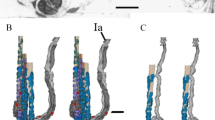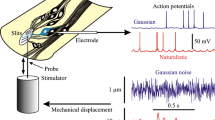Summary
In isolated receptors the impulse frequency following “step” stretches had a highly significant correlation with both muscle length and tension; any deviations from linearity were in opposite directions, impulse frequency rising more quickly than linearly with length and more slowly than linearly with tension. The impulse frequency decayed according to a power function of time from application of a step increase in length. A transfer function was derived and used to predict responses to sinusoidal and constant velocity stretches. The experimental data generally agreed with predictions. The deviations that were found could be accounted for by considering quantitatively any non-linearity between frequency and length, the adaptation of the impulse frequency to constant currents, the all-or-none nature of the action potential, and the viscous forces present during dynamic stretch. The approximately linear relationship between impulse frequency and muscle length and muscle tension is discussed. Muscle tension appears to be the more direct causal agent of impulse generation. Possible physical bases for the transfer function are also considered.
Similar content being viewed by others
References
Alexandrowicz, J. S.: Muscle receptor organs in the abdomen of Homarus vulgaris and Palinurus vulgaris. Quart. J. micr. Sci. 92, 163–199 (1951).
Bannister, W. J.: A transistor ramp generator. J. Physiol. (Lond.) 181, 12P (1965).
Brown, M. C.: Electrical and mechanical stimulation of slowly adapting stretch receptors in the crayfish. J. Physiol. (Lond.) 181, 1–2P (1965).
Chapman, K. M., and R. S. Smith: A linear transfer function underlying impulse frequency modulation in a cockroach mechanoreceptor. Nature (Lond.) 197, 699–700 (1963).
Clark, R. N.: Introduction to automatic control systems. London: John Wiley & Sons 1962.
Eyzaguirre, C., and S. W. Kuffler: Processes of excitation in the dendrites and in the soma of single isolated sensory nerve cells of the lobster and crayfish. J. gen. Physiol. 39, 87–119 (1955).
Guest, P. G.: Numerical methods of curve fitting. Cambridge: University Press 1961.
Harreveld, A. van: A physiological solution for freshwater crustaceans. Proc. Soc. exp. Biol. (N.Y.) 34, 428–432 (1936).
Hermann, H. T., and L. Stark: Single unit responses in a primitive photoreceptor organ. J. Neurophysiol. 26, 215–228 (1963).
Hodgman, M. S. (ed.): C. R. C. standard mathematical tables. Cleveland, Ohio: Chemical Rubber Publ. Co. 1957.
Kirschfeld, K., u. W. Reichardt: Die Verarbeitung stationärer optischer Nachrichten im Komplexauge von Limulus. Kybernetik 2, 43–61 (1964).
Krnjevic, K., and M. van Gelder: Tension changes in crayfish stretch receptors. J. Physiol. (Lond.) 159, 310–325 (1961).
Landgren, S.: On the excitation mechanism of the carotid baroceptors. Acta physiol. scand. 26, 1–34 (1953).
Lippold, O. C. J., J. G. Nicholls, and J. W. T. Redfearn: Electrical and mechanical factors in the adaptation of a mammalian muscle spindle. J. Physiol. (Lond.) 153, 209–217 (1960).
Machin, K. E.: The electronic simulation of the load applied to an insect muscle. Electron. Engng. 31, 740–744 (1959).
Matthews, P. B. C.: Apparatus for studying the response of muscle spindles to stretching. J. Physiol. (Lond.) 169, 58–60P (1963a); - The response of de-efferented muscle spindle receptors to stretching at different velocities. J. Physiol. (Lond.) 168, 660–678 (1963b); - Muscle spindles and their motor control. Physiol. Eev. 44, 219–288 (1964).
Nakajima, S.: Adaptation in stretch receptor neurons of crayfish. Science 146, 1168–1170 (1964).
Partridge, L. D.: Stretch reflex interactions studied with the aid of simulation. Amer. J. phys. Med. 44, 78–100 (1965).
Poppele, R. W., A. Borsellino, and C. A. Terzuolo: Responses of the lobster stretch receptor to sinusoidal input. Fed. Proc. 24, 141 (1965).
Smith, R. S.: Activity of intrafusal muscle fibres in muscle spindles of Xenopus laevis. Acta physiol. scand. 60, 223–239 (1964).
Stein, R. B.: A high speed timer and recorder for computer analysis of physiological data. J. Physiol. (Lond.) 181, 5–6P (1965); - Studies on the temporal characteristics of neuronal activity. D. Phil. Thesis, Oxford University 1966.
Tapper, D. N.: Input-output relationships of a skin tactile sensory unit of the cat. Trans. N.Y. Acad. Sci. 26, 697–701 (1964).
Terzuolo, C. A., and Y. Washizu: Relation between stimulus strength, generator potential and impulse frequency in stretch receptor of Crustacea. J. Neurophysiol. 25, 56–66 (1962).
Weevers, R. de G.: The physiology of a lepidopteran muscle receptor. 1. The sensory response to stretching. J. exp. Biol. 44, 177–194 (1966).
Wendler, L.: Über die Wirkungskette zwischen Reiz und Erregung (Versuche an den abdominalen Streckreceptoren dekapoder Krebse). Z. vergl. Physiol. 47, 279–315 (1963).
Wendler, L., u. D. Burkhardt: Zeitlich abklingende Vorgänge in der Wirkungskette zwischen Reiz und Erregung (Versuche an den abdominalen Streckreceptoren dekapoder Krebse). Z. Naturforsch. 16b, 464–469 (1961).
Wiersma, C. A. G., E. Furshpan, and E. Florey: Physiological and pharmacological observations on muscle receptor organs of the crayfish Cambarus clarkii Girard. J. exp. Biol. 30, 136–150 (1953).
Author information
Authors and Affiliations
Rights and permissions
About this article
Cite this article
Brown, M.C., Stein, R.B. Quantitative studies on the slowly adapting stretch receptor of the crayfish. Kybernetik 3, 175–185 (1966). https://doi.org/10.1007/BF00290253
Received:
Published:
Issue Date:
DOI: https://doi.org/10.1007/BF00290253




